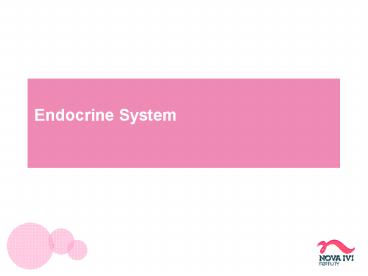Endocrine System - PowerPoint PPT Presentation
Title:
Endocrine System
Description:
The endocrine system refers to the collection of glands of an organism that secrete hormones directly into the circulatory system to be carried towards distant target organs. – PowerPoint PPT presentation
Number of Views:357
Title: Endocrine System
1
Endocrine System
2
Systems of Human Body
- When a bunch of organs work together on one big
project, thats called a system. - Skeletal
- Digestive
- Muscular
- Lymphatic/Immune
- Endocrine
- Nervous
- Reproductive
- Urinary
- Cardio-vascular
3
Glands
- A Gland is a group of cells or tissue that
produces and secretes or gives off chemicals.
Releases their secretions through ducts
Releases their secretions directly in blood stream
4
Endocrine Glands
1
1
2
4
2
2
2
5
Hormone
- Hormone is a chemical substance that is secreted
into the body fluid by cells that exerts a
physiological control effect on other cells of
the body. Hormones transfer information and
instructions from one set of cells to another. - The endocrine system is instrumental in
regulating mood, growth and development, tissue
function and metabolism as well as sexual
function Reproductive processes.
6
Properties of Hormone
- Hormones are informational molecules.
- Hormones are highly specific in nature.
- Hormones stimulate or inhibit specific biological
process. - The effect of hormones is slow and lingering.
- Their deficiency may lead to serious
consequences. - Hormones show feed-back mechanism.
7
Classification of Hormone
8
Hormone Receptors
- These are specialized proteins capable of binding
the hormone molecule with very high specificity
and affinity. - Receptor proteins are present either on surface
of a cell or in its interior. - Down Regulation Binding of receptors by hormone
leads to decrease in the number of receptors,
which decreases the response of target tissue to
hormone.
9
Hormone Receptors
10
Mode of Action
Receptor on the surface of the cell membrane
Receptor inside the cell cytoplasm
All hormones acts by binding to specific receptor
proteins in the target tissue cells.
11
Hypothalamus
- The hypothalamus is a collection of specialized
cells that is located in the lower central part
of the brain. - Is the main link between the endocrine and
nervous systems. - Nerve cells in the hypothalamus control the
pituitary - gland by producing chemicals that either
stimulate or suppress hormone secretions from the
pituitary.
12
Hormone Secreted by Hypothalamus
- Thyrotropin-releasing hormone (TRH)
- Gonadotrophin-releasing hormone (GnRH)
- Growth hormone-releasing hormone (GHRH)
- Corticotropin-releasing hormone (CRH)
- Somatostatin (Growth factor-inhibiting hormone)
- Dopamine
13
Pituitary Gland
- It is unpaired, pea shaped, small gland about 1
cm, in diameter 0.5 to 1 gram in weight - Connected to the hypothalamus by the pituitary
stalk - Divisible into
- Anterior Lobe (Adenohypophysis)
- Posterior Lobe (Neurohypophysis
- It is also called as hypophysis (from Greek,
lying under)
14
Pituitary Gland
15
Hormones
Function
Anterior Lobe (Adenohypophysis)
- Promotes Growth,
- Controls Metabolism
- Stimulates growth and
- activity of thyroid gland
- Synthesis of cortisols
- Stimulation of Lactation
- Growth Hormones
- Thyroid Stimulating Hormone
- Adrenocorticotropic Hormones
- Prolactin
16
Anterior Lobe (Adenohypophysis)
- In females, controls the growth of ovarian
follicle. - In males, stimulates spermatogenesis.
- In females, promotes maturation of follicle and
ovulation. - In males, stimulates interstitial cells.
- Gonadotrophic Hormones
- Follicle Stimulating Hormone
- Luteinizing Hormone
17
Hormones
Function
Posterior Lobe (Neurohypophysis)
- Promotes contraction of uterine muscle
- Promotes contraction of myoepithelial cells of
lactating breast. - Increases reabsorption of water
- Contraction of smooth muscle.
- Oxytocin
- Anti Diuretic Hormone
18
GnRH (Gonadotrophin Releasing Hormone)
- Decapeptide, made up of 10 a.a.
- Secretes two hormones FSH/LH
- Secreted in highly pulsatile manner.
- The amplitude and the frequency at which GnRH is
produced plays an important role in determining
which hormone will be produced. - Higher Frequency LH is secreted
- Lower frequency FSH is secreted.
- The half life is 3-5 mins.
19
Hypothalamus
RH
Pituitary Gland
TH
Inhibitory Effect
Stimulatory Effect
Target Gland
Hormone Secreted in Blood
20
HPO Axis
Hypothalamus
GnRH
Feedback to Hypothalamus for secretions of FSH
and LH
Pituitary Gland
FSH
LH
Ovary
Estrogen
21
Thank You































